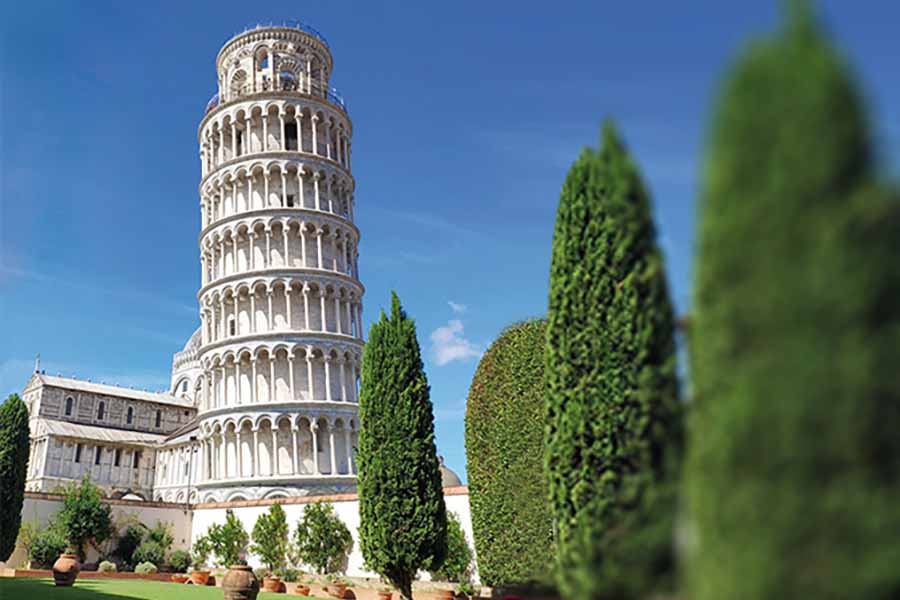The Leaning Tower of Pisa (Italian: Torre pendente di Pisa) stands as one of Italy’s most recognized landmarks, an architectural marvel famous worldwide for its unintended tilt. Located in the Piazza dei Miracoli (Square of Miracles) in Pisa, Tuscany, this bell tower, or campanile, has an 800-year history filled with engineering missteps, centuries of efforts to prevent its collapse, and finally, stabilization that secures its future for the coming centuries.
The History of the Leaning Tower
Construction of the Leaning Tower of Pisa began in 1173 as the third and final structure in the city’s cathedral complex, commissioned to demonstrate the wealth and power of Pisa. It was intended to be a perfectly straight, freestanding bell tower for the nearby Cathedral.
Built primarily of white marble, the circular tower’s foundations were laid in a shallow, three-meter-deep pit. By the time the third of its eight planned stories was completed around 1178, the tower began to sink and lean to the south. This early tilt was caused by the unstable subsoil beneath the base.
The construction was subsequently halted for nearly a century due due to ongoing military conflicts. This pause, however, ironically allowed the underlying soil to settle somewhat, which likely prevented the tower from toppling over completely in its early years.
When construction resumed in 1272, engineers attempted to compensate for the lean by making the new stories slightly taller on the short (south) side. This effort only made the structure heavier and caused it to sink further, though it gave the tower its slight, noticeable curve. The tower was finally completed in 1372 with the addition of the bell chamber, almost 200 years after construction began.
At its highest point, the height leaning tower of pisa reaches approximately 55.86 meters (about 183 feet) from the ground on the low side, and 56.67 meters on the high side. By the 1990s, the tilt had reached a dangerous 5.5 degrees, prompting a major international stabilization effort that closed the tower to visitors. Following successful soil-extraction work, the tilt was reduced and the tower was reopened in 2001, deemed stable for at least another 200 years.
Why Does the Tower Lean?
The answer to “why does the tower lean?” is a combination of poor architectural design and unstable geology.
- Shallow Foundation: The original foundation was only three meters deep, which was insufficient for a structure of its height and 14,500 metric ton weight.
- Soft Alluvial Soil: The entire area of Pisa sits on soft, alluvial soil composed of clay, sand, and shells from nearby rivers. This subsoil is highly compressible and cannot support heavy loads uniformly.
The tower began to sink unevenly almost immediately because the soft ground under one side couldn’t support the sheer weight. This continuous sinking and tilting is what defines the tower’s unique appearance today.
Visiting Tips
The Leaning Tower of Pisa remains one of Italy’s most visited attractions. Here are a few essential tips for your visit:
- Tickets: Entry to the Cathedral is typically free with a timed pass, but climbing the Tower requires a separate, timed tickets. It is highly recommended to book your tickets online in advance, especially during peak season, as availability is limited for safety reasons.
- Safety Restrictions: Children under the age of 8 are not permitted to climb the Tower. Visitors under 18 must be accompanied by an adult. For safety, all bags and luggage must be checked at the cloakroom before the visit, as they are not allowed inside the tower.
- The Climb: Climbing the 296 marble steps to the top is an unforgettable experience, offering panoramic views and a unique sensation of the tilt as you ascend. Be prepared for a narrow, winding staircase.
- What Else to See: The Tower is just one part of the UNESCO World Heritage site of the Piazza dei Miracoli. Be sure to explore the stunning Pisa Cathedral, the Baptistery, and the Camposanto Monumentale (cemetery).

